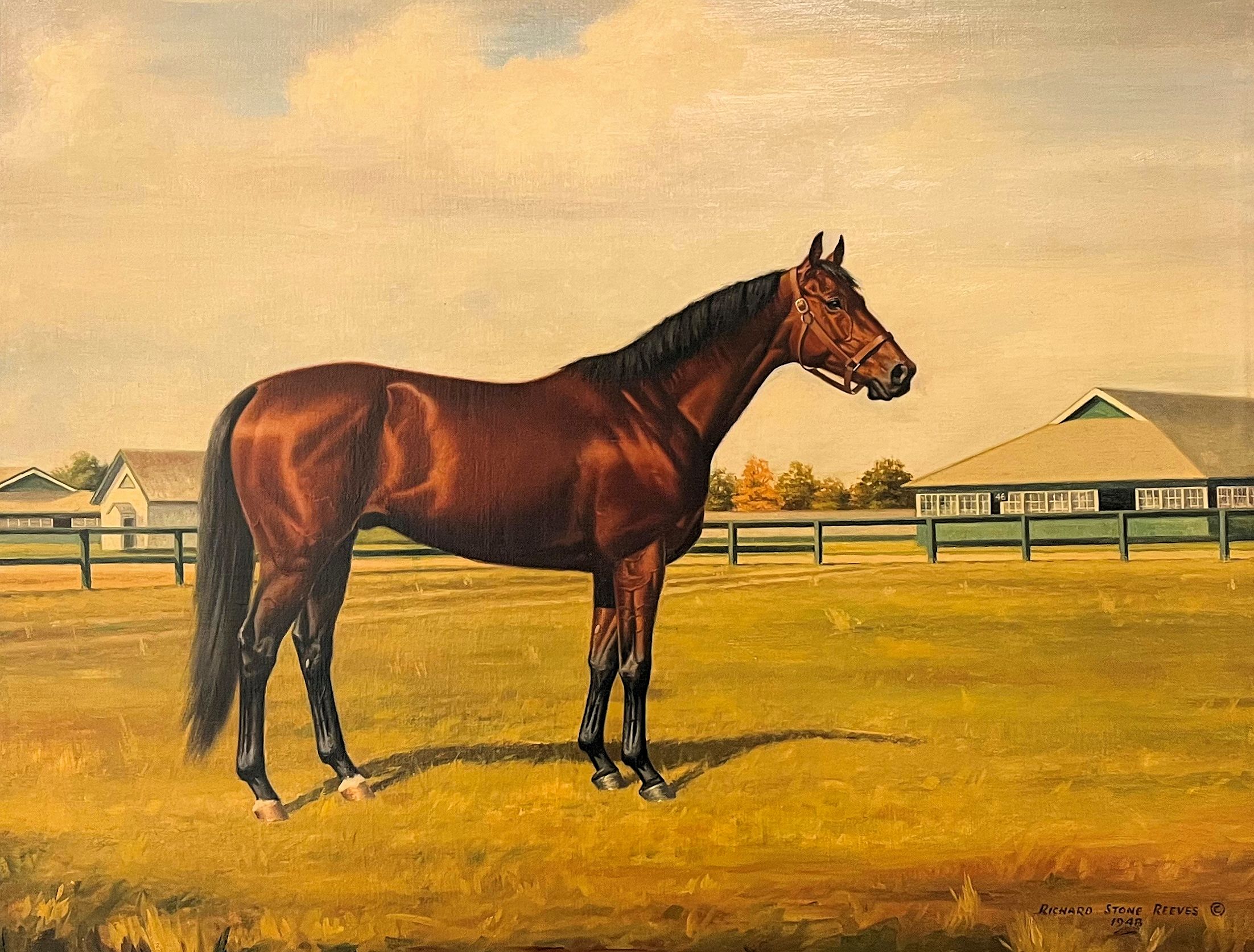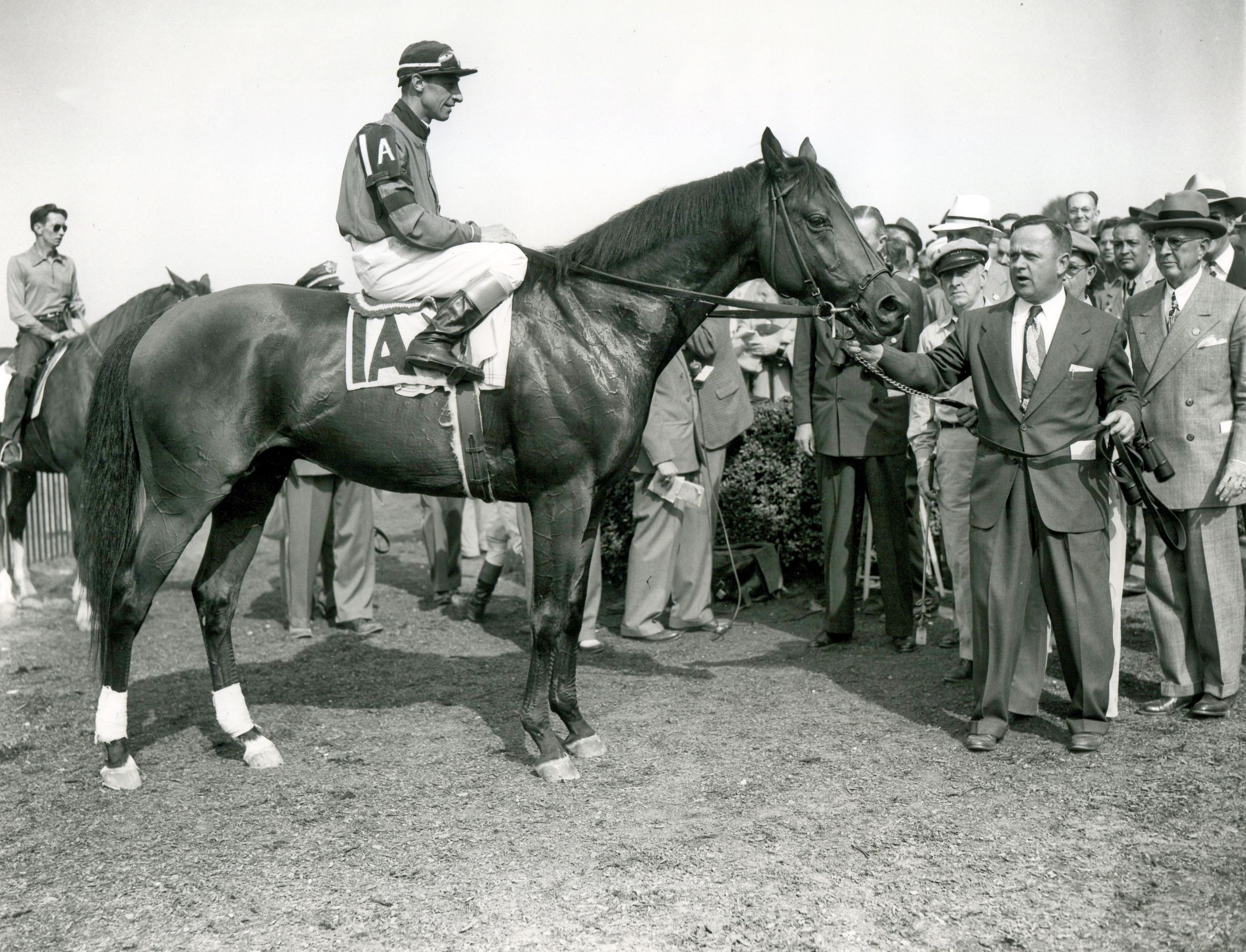Citation's crowning achievement

Seventy-five years ago, the Calumet Farm legend became America’s eighth Triple Crown winner en route to immortal status
By Brien Bouyea
Hall of Fame and Communications Director
In the 1940s, baseball and horse racing could both make a rightful claim as America’s greatest pastime. When writers of the era partook in their quarrels about the best of the best — the iconic dynasties of the respective sports — the discussions inevitably turned to the New York Yankees and Calumet Farm. The Bronx Bombers won four World Series titles during the decade and featured future Hall of Famers such as Joe DiMaggio, Yogi Berra, and Phil Rizzuto. Calumet, meanwhile, dominated to the tune of 10 Triple Crown race victories in the 1940s. The farm’s embarrassment of riches included four winners of both the Kentucky Derby and Preakness Stakes and two Triple Crown champions — Whirlaway in 1941 and Citation in 1948.
Citation, who became America’s eighth Triple Crown winner 75 years ago, is widely regarded as the best of the Calumet luminaries. In 1999, a BloodHorse panel of racing historians ranked Citation No. 3 behind only Man o’ War and Secretariat among the top racehorses of the 20th century. Six other Calumet horses — Hall of Famers Whirlaway (No. 26), Armed (No. 39), Coaltown (No. 47), Twilight Tear (No. 59), Two Lea (No. 77), and Bewitch (No. 89) — also made the top 100. Citation was Calumet’s DiMaggio, an athlete whose combination of elite talent, rare achievement, and charisma led to cultural phenom status.
A bay son of Calumet foundation sire Bull Lea out of the Hyperion mare Hydroplane II (GB), Citation was the gem of arguably the greatest foal crop from an individual stallion in racing history. Bull Lea’s 1945 crop also included Calumet legends Coaltown and Bewitch, but it was the mighty Citation who prompted his trainer, Horace A. “Jimmy” Jones, to describe him as “the best horse I ever saw.”
Citation debuted with a victory at Havre de Grace in Maryland on April 2, 1947. He won his next four starts before finishing second to stablemate Bewitch in the Washington Park Futurity. Citation then won the Futurity Trial and Futurity Stakes at Belmont Park and closed out his juvenile season back in Maryland with a victory in the Pimlico Futurity. With eight wins from nine starts, Citation was named Champion 2-Year-Old Male.
As a sophomore in 1948, Citation delivered one of the most remarkable campaigns in racing history, fashioning a 16-race win streak that included the Triple Crown, and losing only once in 20 starts. He began by making Hialeah his winter playground with four victories at the Florida track in February. In the Seminole Handicap, he defeated older stablemate Armed, the reigning Horse of the Year.
Citation was then put away until April, when he was partnered with jockey Eddie Arcaro for the first time. Citation had previously been ridden by Al Snider in nine of his 12 wins, including the four at Hialeah, but Snider disappeared while fishing off the Florida Keys in early March and was presumed to have drowned in a storm. Snider’s body was never recovered, but a search party found his damaged skiff eight days after he disappeared on an island south of Everglades City.
With Arcaro aboard for the Chesapeake Trial at Havre de Grace, Citation caught a muddy track and finished second to Saggy, snapping his seven-race win streak. Arcaro, however, wasn’t disappointed in the result.
“I could have caught him,” Arcaro said of Saggy, “but I wasn’t about to burn up that horse for an $8,300 pot with all those $100,000 races ahead.”
Five days later, Citation and Arcaro won the Chesapeake Stakes by 4½ lengths (Saggy was unplaced). The victory began an incredible run of 16 consecutive wins for Citation. After winning the Derby Trial, Citation met stablemate Coaltown in the 74th running of the Kentucky Derby on May 1. Coaltown, who set a track record in the Blue Grass Stakes at Keeneland, was expected to give Citation a run for his money in the Derby, but his effort was in vain. Citation won with ease by 3½ lengths on a sloppy track, covering the 10 furlongs in 2:05. Coaltown completed the Calumet exacta, three lengths ahead of My Request.
Citation next defeated Vulcan’s Forge by 5½ lengths in the Preakness on May 15, then set a track standard of 2:03 for 1¼ miles in the Jersey Derby at Garden State Park on May 29. On June 12, he met seven overmatched foes in the Belmont Stakes. At the wire, Citation was eight lengths clear of Better Self in 2:28⅕, which equaled Count Fleet’s stakes record from 1943.
Following the Belmont, Joe Palmer wrote in The BloodHorse that Citation was worthy of being compared to the great Man o’ War.
“Here, at long last, was the horse we’d been looking for since a great golden chestnut roared to a stop at Kenilworth Park back in 1920, Palmer wrote, referencing Man o’ War’s final career race in Canada. “I could not see Arcaro move. But with some slight dropping of the hands, he released the swelling energy of the great racer beneath him. Citation opened away. He was three-sixteenths away, but he was home.”
Citation summered in Chicago, winning the Stars and Stripes Handicap at Arlington Park, followed by an allowance and the American Derby at Washington Park. Returning to Belmont Park in late September, he defeated First Flight in the Sysonby Mile, then three days later trounced Phalanx in the Jockey Club Gold Cup at two miles. Citation closed out his year with a walkover in the Pimlico Special and a pair of easy wins at Tanforan in California to push his win streak to 15 and an overall record of 19 wins from 20 starts for the year. His victories in 1948 took place at 10 different tracks in seven states. With seasonal earnings of $709,470 — a new record for a single year — Citation was an easy selection as Horse of the Year and Champion 3-Year-Old Male. He was also chosen by Daily Racing Form as its Champion Handicap Male. At this point, Citation had won 27 of 29 starts and finished second in his two defeats.
At the height of his success, Citation was forced to the sidelines. An osselet injury (inflammation of the connective tissue that surrounds the cannon bone and the fetlock joint) prevented him from racing as a 4-year-old, but it was not the end of his career.
Returning in 1950 as a 5-year-old, Citation extended his win streak to 16 with a victory in a $5,000 allowance at Santa Anita in January. He then finished second in his next five races, including a pair of losses to future Hall of Famer Noor in the Santa Anita and San Juan Capistrano handicaps. Noor carried 22 pounds less than Citation in the Santa Anita Handicap and 13 less when he beat him by a nose in the San Juan Capistrano. After bouncing back to win the Golden Gate Mile Handicap, Citation met Noor twice more. In receipt of five pounds in the Forty-Niners Handicap at Golden Gate, Noor earned a neck victory. A week later in the Golden Gate Handicap, Citation was in receipt of a pound from Noor, but the Irish import defeated Citation again, this time by three lengths. Although he had been beaten four consecutive times by Noor, there was no shame in any of the defeats. Noor set an American record in the San Juan Capistrano (2:52⅘ for 1¾ miles) and world records in the Forty-Niners Handicap (1:46⅘ for 1⅛ miles) and Golden Gate Handicap (1:58⅕ for 1¼ miles).
Put away for the year after the Golden Gate Handicap, Citation came back as a 6-year-old in 1951. After losing four straight to begin his campaign, Citation found some of his old form at Hollywood Park, winning a $15,000 handicap, then defeating Bewitch in both the American Handicap and Hollywood Gold Cup. In winning the latter — his 22nd stakes victory — Citation became the first horse to surpass $1 million in earnings. With nothing more to accomplish, he was retired soon after the Gold Cup.
Although no longer the force he once was, Citation shared 1951 Champion Handicap Male honors with future Hall of Famer Hill Prince. Citation’s final ledger was 32-10-2 from 45 starts and record earnings of $1,085,760 earned him induction into the Hall of Fame in 1959.
Returning to Calumet Farm for stud duty, Citation sired Hall of Fame member Silver Spoon and 1956 Preakness winner Fabius, as well as the dams of 33 stakes winners. He died at the age of 25 in 1970 and was buried at Calumet close to his sire and dam. Three years later, another of the all-time greats, Secretariat, became the first horse since Citation a quarter-century earlier to sweep the Triple Crown.
Arcaro, who won a record 17 races in the Triple Crown series and is regarded by many historians as the greatest jockey ever, reserved his finest praise for the 1948 Triple Crown winner.
“Citation was the best ever,” Arcaro said. “He was so fast he scared me.”
Citation (KY)

Lifespan: 1945 — 1970
Pedigree: Bull Lea—Hydroplane II, by Hyperion
Breeder: Calumet Farm
Owner: Calumet Farm
Trainer: Benjamin A. Jones and Horace A. "Jimmy" Jones
Career dates: 1947 – 1951
Record: 45 starts, 32 wins, 10 seconds, 1 third
Earnings: $1,085,760
Notable:
- America's eighth Triple Crown winner 1948
- Champion 2-Year-Old Male 1947
- Horse of the Year 1948
- Champion 3-Year-Old Male 1948
- Champion Handicap Male 1948 (Daily Racing Form)
- Champion Older Turf Male 1951 (Turf and Sport Digest)
- First horse to earn $1 million
- Won 16 consecutive races
- Inducted into the Hall of Fame in 1959




